|
March 1972 Popular Electronics
 Table of Contents
Table of Contents
Wax nostalgic about and learn from the history of early electronics. See articles
from
Popular Electronics,
published October 1954 - April 1985. All copyrights are hereby acknowledged.
|
Author Len Buckwalter states
in this 1972 "Communications Satellites" article from Popular Electronics
magazine that at the time, radio channels were so crowded in California that police
were using spectrum in the television broadcast band for communication. The FCC
was denying recreational boaters channel space on favor of commercial operators.
The problem could not be blamed on available frequency space, but rather on the
lack of inexpensive electronic components that worked above a kHz or so. Nowadays
when you read in the news about such desperate need of spectrum that network owners
pay millions or billions of dollars for a few measly MHz of bandwidth, the cause
is truly an overabundance of devices vying for space. Although truthfully, you could
claim that exactly the same scenario is playing out today while semiconductor companies
strive to bring low cost components in the millimeter wave bands above 30 GHz.
These Radio Relays in the Sky Are Helping Us Cope with Today's
Communications Explosion
By Len Buckwalter

Whether you are a ham operator, telephone dialer, airline pilot, police dispatcher,
computer operator, shortwave listener, or anyone who wants to exchange information
by wire or radio, you're aware of a world in the midst of a communications explosion.
Phone circuits are often clogged, radio frequencies are so congested that police
in California speak over TV channels, and boat owners are forced to abandon some
of their bands to commercial mariners. A million CB'ers seek more channels for personal
talk and air traffic controllers urgently need data links to keep aircraft safely
apart.
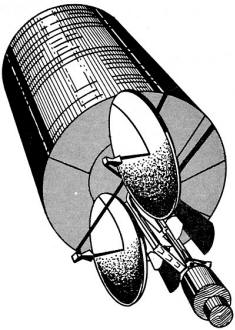 Long-range planners insist that these distressing
symptoms only hint of what's to come. By the end of this decade, they see a whopping
500 percent increase in global communications. They predict the sound of human voices
on phone lines will soon be exceeded by the chatter of machines conversing with
each other. And the intense pressure to communicate can only increase as developing
nations emerge, or as new electronic services are brought into the home. Long-range planners insist that these distressing
symptoms only hint of what's to come. By the end of this decade, they see a whopping
500 percent increase in global communications. They predict the sound of human voices
on phone lines will soon be exceeded by the chatter of machines conversing with
each other. And the intense pressure to communicate can only increase as developing
nations emerge, or as new electronic services are brought into the home.
But thanks to the communications satellite, there should be more room for everyone.
Today, a single space vehicle can carry more traffic than all the transatlantic
undersea cables combined. Merely three satellites deployed about the earth can "see"
every point on the globe, and join any two of them as no cable can. Besides international
coverage, a rising generation of "domestic" satellites is filling in sparsely populated
regions. This is about to happen in the northern wilderness where cables are costly
to lay. Canada has agreed to pay the U. S. $30 million for launching three satellites
in 1972, with a similar system planned for Alaska. These developments make it nearly
incomprehensible that the first commercial communications satellite thundered off
Cape Kennedy only seven short years ago.
Marconi Bridged the Ocean. The concept of a "radio relay tower
in the sky" is often dated at 1945, but its genesis goes clear back to Marconi himself.
He had stumbled on the "passive reflector" idea when his signals bridged the ocean
in 1901. Although Marconi had no inkling why his signals crossed the Atlantic, it
mattered little at the time. The breakthrough was that long-haul communications
were finally freed from the wire. Until then, linking continents was done by the
ship Great Eastern which carried on long voyages mountainous stores of food and
equipment to lay cable on the ocean floor. It took two hours to merely lower the
30-ton cable to the bottom. After the job was completed, the system could carry
only a limited number of messages. (Even the most modern cable proposed today has
a capacity of only 840 telephone circuits.)
Marconi, on the other hand, had captured signals across the Atlantic on a kite,
a 600-foot aerial, coils, capacitors, an earphone and an inefficient detector. He
had unwittingly used nature's communications satellite, the ionosphere. This well-known
electrical mirror hovers near the top of the atmosphere where it intercepts radio
signals from the earth. If angles are correct, the signals are reflected downward
and return to the surface at some distant point. The phenomenon is curiously reminiscent
of the first generation of crude, passive communications satellites.
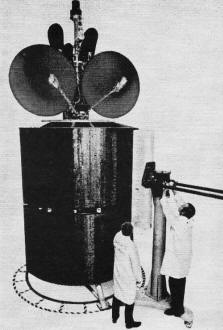
Intelsat IV satellite is shown here being tested in the Hughes
RF laboratory.
Besides achieving great distance, Marconi had produced a second miracle: tremendous
increase in bandwidth, a precious commodity in any communications medium. His experiments
soon led to the opening of a broad path for global communications and international
broadcasting between 3 and 30 MHz. This is the high-frequency band (HF) where the
ionospheric "skip" effect is most efficient. If a single voice message requires
a total bandwidth of 4 kHz, then consider that the entire shortwave region from
3 to 30 MHz will accommodate only about 7,000 messages. As any ham or SWL knows,
the actual capacity is much smaller because of fading, noise, solar flares, radio
blackouts and other caprices of the ionosphere. Nevertheless it provided the most
important transmission medium for the first half-century of global communications.
Today the ionosphere groans from overload. The ham who chases DX fights through
unbelievable interference; CB'ers suffer from the howl of heterodynes from local
and distant stations; and nations enter delicate negotiations to parcel out precious
frequencies. And the pressure increases as the nature of our communications demands
greater bandwidth than ever. A TV channel, for example, consumes a 6-MHz slice of
the spectrum. This alone gobbles up about 1500 voice circuits and makes international
TV a technical impracticality between 3 and 30 MHz.
Passive Reflectors. The first signs of relief appeared in 1946. Like Marconi
forty-five years earlier, experimenters wanted to exploit a natural reflector, only
now it was the moon. It was known that if a signal were high enough in frequency,
it would pass through the ionosphere in a straight line and be lost in space. Why
not, went the theory, use the moon as a passive reflector to return the signal?
The U.S. Army Signal Corps did just that when it swung a radar antenna toward the
lunar surface and fired a pulse of microwave energy. Slightly more than two seconds
later a weak, noisy signal returned and was heard in the receiver. It was powerful
evidence of the feasibility of a true communications satellite.
Suddenly an idea suggested a year earlier (1945) by a British science writer
no longer smacked of science fiction. Arthur C. Clarke (who wrote the film "2001"),
and others before him, had dreamed up a novel concept of artificial satellites orbiting
the earth to serve as radio relay stations. He calculated that a satellite circling
at a height of some 22,000 miles would seem to be fixed over a spot on the earth's
surface. At this altitude the satellite would take 24 hours to revolve once around
the planet. Since the earth also takes this time for one rotation, the satellite
would appear to remain in one position. This could provide an unrivalled platform
for retransmitting radio signals over the horizon. Clarke's predictions proved surprisingly
accurate.
By 1958 the U. S. Air Force launched the first true communications satellite.
Named Score, it was primitive by today's standards, its payload little more than
a tape recorder playing a Christmas greeting back to earth from orbit. (President
Eisenhower had pr-recorded the message on the ground.) The conventional batteries
that powered the satellite went dead in 12 days. (Today the power lasts seven years.)
But Score was hailed as the first "active" satellite because it didn't passively
bounce back signals to earth but contained active, powered circuits.
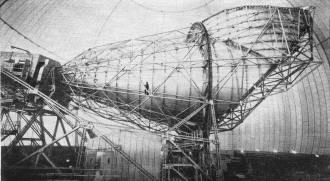
The big 380-ton horn antenna at the earth station at Andover,
Maine, is used by Comsat to transmit and receive satellite signals between U.S.
and Europe.
The heyday of the passive reflector came in 1959 when Bell Telephone Labs in
New Jersey communicated with colleagues in California during Project Moonbounce
(again using the moon.) This soon led to a manmade reflector called Echo. Launched
into orbit as a tiny packet, Echo reacted to the sun's rays by expanding into a
100-ft balloon with an aluminum foil skin. This created a metal surface orbiting
1000 miles aloft. Although it became wrinkled and deflated after three years, Echo
was used to refine the technology needed in the ground stations. During this period,
engineers developed horn-reflector antennas of great gain and directionality, extremely
low-noise receivers and new tracking techniques by computer. The passive reflector
idea, though, was short-lived.
A far more sophisticated package roared off the pad in 1960. Called Courier I-B,
it was studded with 20,000 solar cells and could sustain itself by converting the
sun's energy into electricity. Equipped with four receivers, four transmitters and
five tape recorders it demonstrated the possibility of storing received signals
on tape, then re-transmitting them at a later time. This was the solution to the
problem of linking two ground points that could not "see" the satellite at the same
time. Technical difficulties brought Courier to a premature end after 18 days, but
not until it had received and transmitted 118 million words.
Telstar and Later. Courier stirred great scientific interest
but it only hinted of things to come. A series of sensational successes followed
in the summer of 1962. Just before daybreak on a July morning a Thor-Delta rocket
lifted off Cape Kennedy. Minutes later Telstar I, a 3-foot-wide craft was inserted
into an orbit that ranged between 600 and 3,500 miles. During the sixth pass, Telstar
relayed the first live TV program between U.S.A. and Europe. It did it with no time
delay or tape storage: Telstar received and transmitted simultaneously. Below the
TV picture of singer Yves Montand appeared the sub-title on American home TV sets
"Live From France."
Despite its dazzling success, the vehicle fell victim to the hostile environment
of space. Two months after launch, engineers noted the vehicle was not executing
the "T2" command, an order to turn off communications equipment when out of range.
Otherwise there would be a serious drain on the electrical system. Some electronic
detective work revealed the culprit. Sensing devices on Telstar reported the space
vehicle had picked up 100 times more radiation than predicted as it skirted the
Van Allen Belt (which girdles the earth with high-energy electrons.) Acting on this
cue, engineers doused similar Telstar components in the lab with heavy radiation.
They discovered that radiation could penetrate transistor casings and ionize the
gas trapped within. Since gas ions are electrically charged, they interfered with
normal transistor action. Telstar I fell silent six months after launch.
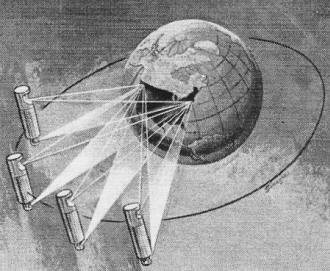
Four domestic satellites proposed by Bell System would provide
83,000 channels for voice, 24 TV, and 64 spares.
These findings protected Telstar II against similar misfortune. A new orbit swung
the vehicle 3000 miles further into space and held it beyond strong radiation belts
for longer periods. What's more, the troublesome gasses inside the transistors were
carefully evacuated during manufacture.
The stage was now set for the first practical, work-a-day communications satellite.
Much had been learned through experiments on these early "low-orbit" vehicles which
swept over the earth to link two points on the earth's surface only hours at a time.
Now the time had come for a satellite system that could provide continuous commercial
service. It happened April 6, 1965, as Early Bird (Intelsat I) rose to its perch
22,300 miles above the Atlantic. Small by today's standards (it weighed 8.5 lb.),
it had a capacity of 240 telephone circuits. But in a single leap it increased the
transatlantic cable capacity by 50 percent! It also turned in a remarkable record
of 100 percent reliability in 3 1/2 years of service.
Just as Clarke predicted back in 1945, Early Bird and the "synchronous" satellites
which followed give the illusion of standing still. Their velocity through space
is about 7000 mph, as the earth's surface below moves at 1000 mph. The reason for
the difference is easily seen by viewing a disc rotating on a phonograph. Although
the disc near the spindle seemingly crawls around, the edge of the record moves
quickly. Both areas, however, complete one turn in exactly the same time.
The satellite's synchronous orbit, which is also described as "geostationary,"
provides a big advantage in satellite communications. The craft is fixed s that
it becomes the equivalent of a permanent tower high above the earth. This is in
contrast to earlier satellites which rapidly looped around the globe to provide
only fleeting periods of communication. The synchronous craft "transponds" continuously;
that is, it receives signals from one earth station and relays them to another station
thousands of miles away at the same time. The shortcoming, though, is that a synchronous
satellite "sees" only one-third of the earth from its fixed position. This is solved
by orbiting three equally spaced satellites for global coverage. Right now there
are vehicles hovering above the Atlantic, Pacific and Indian Oceans to enshroud
the earth.
The synchronous satellites have other shortcomings, too. Remaining parked in
orbit is a tricky condition because celestial mechanics are hardly constant. The
earth's gravitational pull has irregularities which cause orbital drift. The sun
and moon exert pulls which affect the satellite with uneven forces. Even the tiny
push of sunlight against a space craft threatens to disrupt its delicate balance.
Such factors can wobble the vehicle off course and ultimately spin it to a fiery
death in the atmosphere. To see how these problems have been solved, let's examine
the techniques used in Intelsat IV, the newest of the communications satellites.
The Newest Satellite. The Intelsat IV was placed into service
in March, 1971 over the Atlantic. Any irregular force on the vehicle is countered
by pairs of onboard thrusters. Driven by hydrazine, the thrusters are positioned
around the vehicle so command signals from earth can accelerate it in any direction.
Sufficient propellant (270 lb) is stored to keep the craft on station during a design
life of seven years.
Next, there's the matter of keeping certain surfaces pointed earthward. This
is essential to exploit highly directional antennas which make most efficient use
of electrical and radio power. This is done by "Spin-stabilization" to keep the
vehicle rotating at 50 rpm. (Thrusters also regulate this action.) Thus the craft
achieves rigidity in space from a gyroscopic effect. Not all of the satellite is
allowed to spin since those directional antennas must be aimed and held with incredible
accuracy. About half the vehicle, the part with the antennas, is "despun," or counter-rotated,
to bring it to a halt with relation to earth. A transfer assembly on ball bearings
carries power and signals between the rotating halves of the vehicle.
This stable arrangement supports a veritable antenna farm. Two high-gain horns
receive signals from earth and two transmit them back There are several non-directional
antennas to handle the command and telemetry signals which monitor and govern the
vehicle's condition, There are also "spot beam" antennas which can be precisely
aimed at a small region on the earth for point-to-point traffic. These narrow signals
can increase the number of circuits since energy is held within a beam only 4.5
degrees wide.
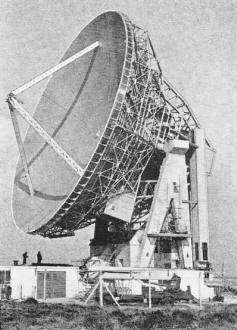
Ground station at Goonhilly Downs in Cornwall, England, uses
steerable 85' parabolic dish to transmit, receive.
Thanks to high-gain antennas in the satellite, as well as huge horns on the ground,
the transmitter power may be only six watts. In a typical transmission, a signal
from the ground is sent to the satellite on a frequency of approximately 6 gigahertz
(6,000 MHz). This is in the microwave spectrum where waves are extremely short in
length and display no bending through the ionosphere. Upon receiving the signal,
one of 12 transponders aboard the satellite retransmits the intelligence toward
earth on 4 gigahertz (4,000 MHz). By separating arriving and departing signals in
frequency, the relay is simultaneous, since the transmitter doesn't block the receiver.
Power for the satellite is derived from 40,000 solar cells which spin in the
sunlight. They produce about 500 watts of primary electrical power (at 24 volts)
to energize transponders and control systems. If a solar eclipse occurs, power is
temporarily obtained from two nickel-cadmium batteries held on charge by about 3000
solar cells. The complete, self-sustaining vehicle is about the weight of a Volkswagen.
What does it add up to in communications capacity? With its 12 transponders operating,
Intelsat IV can provide more than 9,000 two-way telephone circuits (each 4 kHz)
or 12 television channels. In typical operation the satellite carries about 5,000
voice channels and TV. Some transponders aboard feed the spot-beam antennas for
point-to-point traffic, while other transponders feed the horns which cover the
viewable earth disc. Compare Intelsat IV's capacity -a total bandwidth of 432 MHz
- with an ionosphere barely 30 MHz wide. And the satellite is virtually immune to
the vagaries of sun and static. During 1970, the Intelsat III satellite series carried
their traffic without fail during 99.55 percent of the time.
Support from the Ground. Orbiting hardware captures the headlines,
but it would be so much debris without support from earth stations. To gain access
to the system, 30 countries have erected 43 earth stations throughout the world.
These figures are expected to double within the next three years as space communications
continue to reduce traffic costs. It's notable that countries with traditionally
poor communications (Latin America, the Far East, the Near East and Africa) are
taking the great leap forward with the construction of their own earth stations
to participate in the system.
Consider what you'd see at a typical ground facility, like the Bartlett Earth
Station recently completed near Anchorage, Alaska. It communicates through Intelsat
III positioned over the Pacific to provide a direct tie between Alaska and the lower
48 states or Hawaii, Australia and Japan. The station receives locally generated
traffic (telephone, teletypewriter, TV or high-speed data) and sends it through
a huge dish-shaped antenna 98 feet in diameter. Although the array weighs 315 tons,
it can be rapidly rotated toward the satellite and zeroed on target with an accuracy
of 2/100ths of a degree. Signals fly simultaneously to and from the satellite through
the same dish, kept apart by a 2-gigahertz frequency difference. To keep ground
receivers operating at the greatest possible gain, front-end amplifiers are cooled
almost to absolute zero by helium. This slows the molecules in the circuit so they
contribute less noise to the faint signals arriving from above. It takes 16 men
to run Bartlett around the clock.
About 80 percent of the traffic now carried by all satellites is the telephone
message. And it's increasing at a rapid pace. The number of phone calls between
Argentina and the U.S. jumped from 200 to 400 per day last year when satellite service
commenced. TV news pickups and special events via live satellite relay are now routine,
and this will surely increase due to major rate reductions. Today's cost for a minute
of transatlantic TV is $66 - a mere 15 percent of the tariff back in 1965.
Despite the exciting success of the communications satellite, its future sparks
plenty of lively controversy. The privately owned Communications Satellite Corp.
(Comsat) in the U.S. is attempting to accommodate the differing needs of a common
carrier like A.T.&T. and the TV networks. A renewed space race is brewing between
three competing international systems: Intelsat, an organization of 79 nations in
a joint venture; the Franco-German Symphonie satellite and the Russian Molniya.
Technically, some interests are calling for a quick jump to much higher frequencies
- as far as 30,000 MHz - where the bandwidth available is even greater. This is
opposed by others who feel that the state of the art is still years behind such
a plan. They point out that, as the frequencies grow higher, they behave more like
light and are attenuated by rain and other obstacles. But it's a healthy battle
with little of the wasteful duplication of the first space race.
Posted January 31, 2024
(updated from original
post on 10/1/2017)
|

































